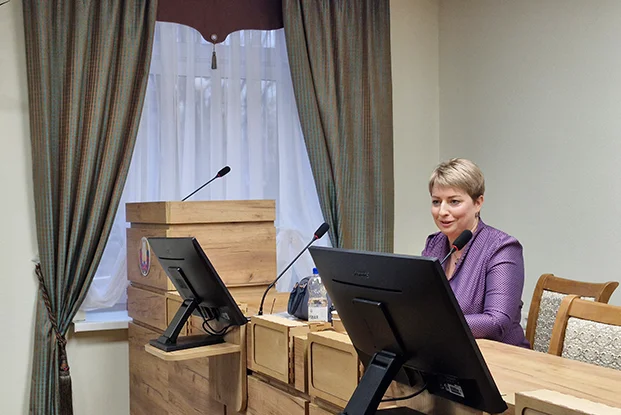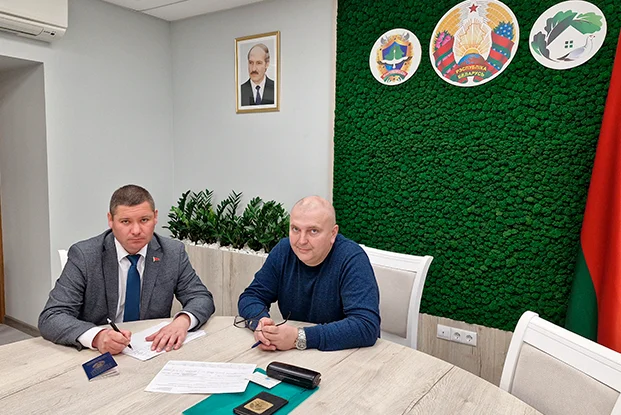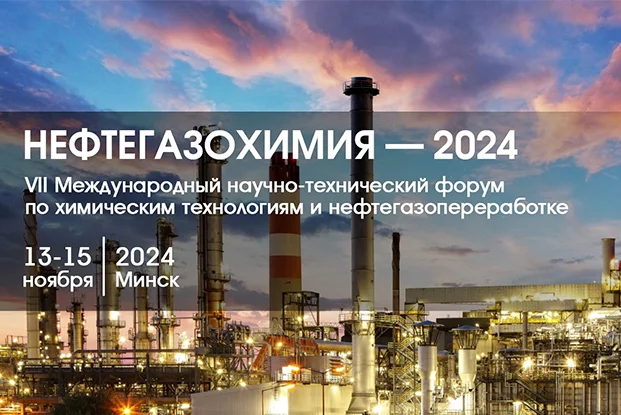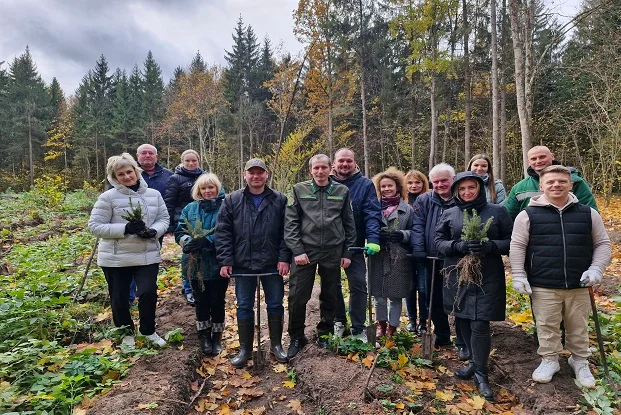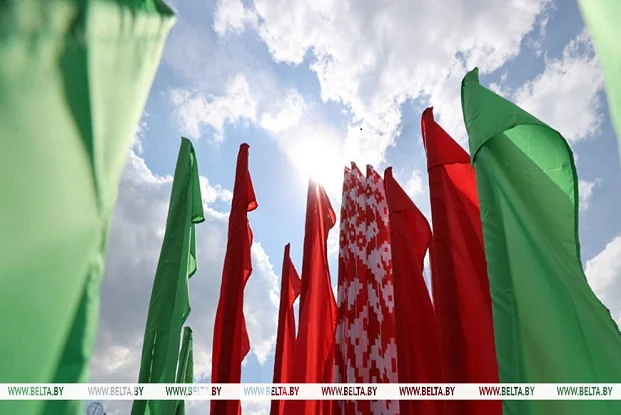In the "FAQ" section, the Republican Center for State Environmental Expertise, Training, Advanced Training and Retraining of Personnel of the Ministry of Natural Resources answers frequently asked questions
In connection with the receipt of numerous questions regarding the clarification of the requirements of the Law of the Republic of Belarus of July 18, 2016 No. 399-Z "On state environmental expertise, strategic environmental assessment and environmental impact assessment" taking into account the amendments and additions introduced by the Law of July 15, 2019 No. 218-Z, including in terms of classifying production infrastructure facilities specified in subparagraph 1.3 of paragraph 1 of Article 5 of the said Law as objects of state environmental expertise, we provide clarifications prepared by the Ministry of Natural Resources on this issue
More information learn form the LINK.
Is a development project with amendments made in terms of increasing the impact on environmental components subject to state environmental review? Has this project previously undergone state environmental review?
According to the second paragraph of subparagraph 1.2 of paragraph 1 of Article 5 of the Law of the Republic of Belarus dated July 18, 2016 No. 399-Z “On State Environmental Expertise, Strategic Assessment and Environmental Impact Assessment” taking into account the amendments in the wording of July 15, 2019 No. 218-Z (hereinafter referred to as the Law), pre-project (pre-investment) documentation for development is considered to be the objects of state environmental expertise. According to subparagraph 1.4 of paragraph 1 of Article 5 of the Law, architectural and, in the case of single-stage design, construction projects for development (including with amendments) are considered to be the objects of state environmental expertise if the design solutions in them do not ensure the standards for permissible impact on the environment and the volumes of use of natural resources specified in the conclusions of the state environmental expertise on pre-project (pre-investment) documentation.
Taking into account the principles and approaches provided for by the Law, we believe that if the development of pre-project (pre-investment) documentation for construction is not envisaged, construction projects (including those with amendments) are not subject to state environmental review.
When developing technical specifications, is it necessary to submit any scientific work for state environmental assessment?
An exhaustive list of documents and (or) information submitted by interested parties for the implementation of the administrative procedure for issuing a state environmental review report is specified in paragraph 3.4.17 of the unified list of administrative procedures carried out by government agencies and other organizations in relation to legal entities and individual entrepreneurs. For draft technical specifications, the list of required documents includes documents on the results of research and (or) experimental design and (or) experimental technological work.
Is a construction project for the construction of a residential multi-apartment building on a site located in a water protection zone subject to state environmental assessment?
According to the provisions of the Law of the Republic of Belarus of July 18, 2016 No. 399-Z “On State Environmental Expertise, Strategic Assessment and Environmental Impact Assessment” taking into account the amendments as amended on July 15, 2019 No. 218-Z (hereinafter referred to as the Law), social infrastructure facilities, such as, for example, residential apartment buildings located within the boundaries of territories subject to special protection, are not objects of state environmental expertise. It is worth noting that in this case, the objects of Article 7 of the Law are not considered.
How can I find out whether an object located in the city of Smolevichi is located in the water protection zone or coastal strip of the Smolevichi Reservoir?
Clause 21 of Article 52 of the Water Code establishes that information on the boundaries of water protection zones and coastal strips, the mode of economic and other activities in water protection zones and coastal strips is communicated to interested legal entities and citizens, including individual entrepreneurs, by local executive and administrative bodies by publishing this information in the media and posting it on their official websites. Thus, you can familiarize yourself with the boundaries of water protection zones and coastal strips of water bodies located within the boundaries of the city of Smolevichi on the official website of the Smolevichi District Executive Committee; if this information is not available there, you have the right to contact the executive committee with a request to post this information in the appropriate section of the website.
Part of the route of the designed water supply network is located within the boundaries of the city of Uzda, and part within the boundaries of the Uzda district. How can we correctly calculate the amount of compensation measures for the removal of other grass cover?
In accordance with paragraph 16 of Article 38 of the Law of the Republic of Belarus “On Plant Life”, compensation measures are not carried out in the case of removal of flower beds, lawns, and other grass cover outside populated areas. Thus, for the area of other grass cover to be removed, located outside the boundaries of the city of Uzda, it is not necessary to calculate the amount of compensation measures. For the area of other grass cover to be removed, located within the boundaries of the city of Uzda, the amount of compensation measures is calculated in accordance with the Regulation on the procedure for determining the conditions for the implementation of compensation measures, approved by Resolution of the Council of Ministers of the Republic of Belarus dated 25.10.2011 No. 1426.
The Center issued a positive conclusion of the state environmental review regarding the design documentation developed by us. Later, it became necessary to make changes to the design documentation, providing for an increase in the impact on environmental components. With respect to the design documentation providing for the said changes, the Center issued a negative conclusion of the state environmental review. Tell me, does the issued negative conclusion on making changes to the design documentation cancel the effect of the previously issued positive conclusion on the design documentation? Is it possible to implement design solutions in accordance with a project for which a positive conclusion of the state environmental review was previously issued?
The cases and procedure for terminating the conclusion of the state environmental assessment are determined by Article 17 of the Law of the Republic of Belarus “On state environmental assessment, strategic environmental assessment and environmental impact assessment” (hereinafter referred to as the Law).
The Law does not contain any provisions providing for the cancellation of a previously issued positive opinion on design documentation in the event of the issuance of a negative opinion with respect to design documentation that provides for changes to the original design documentation.
State environmental assessment is the establishment of compliance of planned design and other decisions (hereinafter referred to as design decisions) contained in pre-design (pre-investment), design and (or) other documentation (hereinafter, unless otherwise provided, referred to as documentation) with the requirements of legislation on environmental protection and rational use of natural resources (Clause 1 of Article 1 of the Law).
Thus, the design solutions contained in the design documentation, in relation to which a positive conclusion of the state environmental review was previously issued, comply with the requirements of the legislation on environmental protection and rational use of natural resources.
And the implementation of design solutions, in accordance with the project, for which a positive conclusion of the state environmental assessment was previously issued, is considered possible.
At the same time, according to Clause 3 of Article 15 of the Law, the implementation of design decisions without a positive conclusion of the state environmental review is prohibited, unless otherwise established by the President of the Republic of Belarus.
Consequently, the implementation of design solutions contained in design documentation that provide for changes for which the Center has issued a negative conclusion from the state environmental review is prohibited.
We ask you to provide information on the location of the designed facility within the boundaries of natural areas subject to special protection (including water protection zones of rivers and reservoirs).
According to Part One of Article 63 of the Law of the Republic of Belarus “On Environmental Protection”, in order to preserve the beneficial qualities of the environment in the Republic of Belarus, the following natural areas are identified as subject to special protection:
- resort areas;
- recreation areas;
- parks, squares and boulevards;
- water protection zones and coastal strips of rivers and reservoirs;
- sanitary protection zones of mineral water deposits and medicinal sapropels;
- sanitary protection zones of water bodies used for domestic and drinking water supply, sanitary protection zones at water intake sites;
- recreational and health-improving and protective forests;
- typical and rare natural landscapes and biotopes; raised bogs, bogs that are the sources of watercourses;
- habitats of wild animals and places of growth of wild plants belonging to species included in the Red Book of the Republic of Belarus;
- natural areas that are important for the reproduction, feeding, wintering and/or migration of wild animals;
- protected areas of specially protected natural territories;
- other territories for which a special protection and use regime has been established.
At the same time, restrictions and prohibitions on the implementation of certain types of economic and other activities may be established in natural areas subject to special protection, which are specified in documents certifying the rights to use a land plot, a forest fund plot, a water body (part thereof), a subsoil plot, hunting and (or) fishing grounds. The specified restrictions and prohibitions are taken into account during the development and implementation, including projects (Part Two of Article 63 of the Law of the Republic of Belarus “On Environmental Protection”).
In addition, local executive and administrative bodies in the field of water protection and use approve projects of water protection zones and coastal strips, establish the boundaries of water protection zones and coastal strips; ensure the maintenance of water protection zones and coastal strips in proper condition, compliance with the regime for carrying out economic and other activities on public lands and reserve lands located within the boundaries of such territories, as well as the designation of these boundaries on the ground with information signs (subparagraphs 2.5, 2.6 of Paragraph 2 of Article 13 of the Water Code of the Republic of Belarus).
At the same time, in accordance with paragraph eight of part two of Article 8 of the Law of the Republic of Belarus “On Drinking Water Supply”, local executive and administrative bodies in the field of drinking water supply, within the limits of their competence, organize sanitary protection zones for sources and systems of drinking water supply and take measures to prevent violations of the regime of these zones.
The Republican Center for State Environmental Expertise, Training, Advanced Training and Retraining of Personnel of the Ministry of Natural Resources is an authorized body whose competence includes the implementation of administrative procedures provided for in paragraph 3.9 (issuance of a conclusion of the state environmental expertise), paragraph 3.18 (issuance of a conclusion on the compliance of a completed construction facility with environmental safety requirements) of the unified list of administrative procedures carried out by government agencies and other organizations in relation to legal entities and individual entrepreneurs, approved by Resolution of the Council of Ministers of the Republic of Belarus dated 17.02.2012 No. 156.
At the same time, the provision of information (data) on the location of a particular object within the boundaries of natural areas subject to special protection does not fall within the competence of the Center.
Taking into account the above, the Center, guided by Clause 3 of Article 10 of the Law of the Republic of Belarus “On Appeals of Citizens and Legal Entities”, leaves the appeal without consideration on the merits and explains that in order to resolve the issue set out in the appeal (provision of information on the location of the designed object within the boundaries of natural areas subject to special protection (including water protection zones of rivers and reservoirs), one should contact the local executive and administrative bodies at the location of the design object.
Please tell me, at what stage is the state environmental assessment of the Brest Battery Plant project?
For the construction project “Battery plant LLC “iPower” with its own boiler house on natural gas at the address: Brest district, FEZ “Brest”, district “Airport” (hereinafter referred to as the construction project of 2017), a positive conclusion of the state environmental examination No. 759/2017 was issued , approved by the order of the State Educational Institution “Republican Center for State Environmental Expertise, Training, Advanced Training and Retraining of Personnel” of the Ministry of Natural Resources and Environmental Protection of the Republic of Belarus dated May 26, 2017 No. 759-E.
In accordance with subparagraph 1.3 of paragraph 1 of Article 5 and subparagraph 1.1 of paragraph 1 of Article 7 of the Law of the Republic of Belarus dated 18.07.2016 No. 399-Z “On state environmental expertise, strategic environmental assessment, environmental impact assessment”, the design documentation for the construction of the plant requires an environmental impact assessment (hereinafter referred to as EIA) and a state environmental expertise due to the fact that the basic size of the sanitary protection zone (hereinafter referred to as SPZ) of the facility is more than 300 meters.
The basic size of the SPZ for lead battery production is 500 m. The SPZ size adopted for the battery plant corresponds to the basic size.
An environmental impact assessment (EIA) was conducted as part of the 2017 construction project. Public discussions were held on the EIA report.
Construction project “Battery plant LLC “iPower” with its own boiler house on natural gas at the address: Brest district, FEZ “Brest”, district “Airport”. Amendments (object: 290476591-550) (hereinafter referred to as amendments to the construction project) in relation to the 2017 construction project, it is not planned to increase the amount of gross emissions of pollutants into the air by more than five percent, an increase in the volume of wastewater by more than by five percent, the purpose of the facility does not change and it is not planned to provide additional land.
Taking into account the requirements of subparagraph 7.7 of paragraph 7 of the “Regulations on the procedure for conducting environmental impact assessment, requirements for the composition of the environmental impact assessment report, requirements for specialists conducting environmental impact assessment”, approved by Resolution of the Council of Ministers of the Republic of Belarus dated 19.01.2017 No. 47, the revision of the EIA report and its public discussions were not carried out.
The 2017 construction project underwent a state examination, during which changes were made to the project, including in terms of ventilation solutions. Based on the results of the state examination, the Republican Unitary Enterprise “Glavgosstroiekspertiza” on the facility “Battery Plant OOO “iPower” with its own boiler house on natural gas at the address: Brest District, FEZ “Brest”, district “Airport” issued a positive conclusion dated 15.02.2018 No. 58-17/18. The ventilation solutions amended in the 2017 construction project (during the state examination) were taken into account when making changes to the construction project. These changes concern the clarification of the air duct diameters and air flow rates for all ventilation systems.
Currently (during the construction of the battery plant), most of the decisions made in the 2017 construction project have been implemented.
The customer purchased new technological, dust and gas cleaning and water cleaning equipment. Technical documentation from the manufacturers (producers) of the declared equipment was received. The documentation contains technical and environmental characteristics of the equipment delivered to the site. It was used by the design organization when making changes to the 2017 construction project.
Previously adopted fundamental decisions in the technological part of the design documentation are retained. Changes have been made taking into account the purchased equipment.
The decisions on the construction of buildings and structures, and the installation of utility networks, provided for in the 2017 construction project, remain in place.
The main decisions taken when making changes to a construction project concern:
- section for receiving sulfuric acid and preparing the electrolyte of the production building in terms of replacing equipment for storing sulfuric acid and diluting sulfuric acid;
- lead powder production section of the production building in terms of: replacement of equipment for lead powder deposition and purification of dusty air;
- section of the formation of batteries of the production building in terms of replacing the cleaning equipment from sulfuric acid aerosols;
- lead tape production section and battery assembly section in terms of replacing gas cleaning equipment;
- industrial wastewater treatment facilities in terms of equipment replacement.
The impact on the components of the natural environment in the design documentation of the facility is determined for the battery plant as a whole, taking into account:
- decisions of the 2017 construction project on ventilation, changed during the state examination of the project;
- solutions modified by changes to the construction project.
Changes and clarifications have been made to the Environmental Protection section of the design documentation: in terms of atmospheric air protection (the parameters of previously designed sources of pollutant emissions into the atmospheric air have been changed, previously unaccounted for sources of emission (process equipment) and sources of pollutant emissions have been taken into account); in terms of water consumption and water disposal – in the battery plant wastewater treatment system and the volumes of domestic wastewater have been clarified; in terms of decisions on the formation of production waste and its handling.
Based on the results of the state environmental assessment, it was concluded that the presented solutions contained in the construction project “Battery plant OOO “iPower” with its own boiler house on natural gas at the address: Brest district, FEZ “Brest”, district “Airport”. Amendments (object: 290476591-550) comply with the requirements of: legislation on the protection of atmospheric air, legislation on the protection and use of water, legislation on the protection and use of wildlife, legislation on the protection and use of flora, legislation on the protection and use of land, legislation on the protection and use of subsoil, legislation on waste management, legislation on state environmental assessment.
A positive (with conditions) conclusion No. 270/2019 of the state environmental review was issued for the construction project “Battery plant of OOO “iPower” with its own boiler house on natural gas at the address: Brest district, FEZ “Brest”, district “Airport”. Amendments (object: 290476591-550).
The assessment of the conformity (or non-conformity) of the actual parameters with the declared values specified in the design documentation for the facility is carried out at the stage of acceptance of the facility into operation, in particular, within the framework of the administrative procedure carried out by the Center “Issuance of a conclusion on the conformity of a completed construction facility with environmental safety requirements”, provided for in paragraph 3.18 of the Unified List of Administrative Procedures Carried Out by Government Agencies and Other Organizations in Relation to Legal Entities and Individual Entrepreneurs, approved by Resolution of the Council of Ministers of the Republic of Belarus dated February 17, 2012 No. 156.
In case of discrepancy between the actual parameters and the design parameters, when accepting the facility into operation, the Center will not issue a conclusion on the compliance of the completed facility with environmental safety requirements.
When removing a tree with several trunks, are compensation measures calculated as for one tree being removed, or should the number of trunks be taken into account?
In the Regulation on the procedure for determining the conditions for the implementation of compensatory plantings or compensatory payments for the cost of removed flora, approved by Resolution No. 1426 of the Council of Ministers of the Republic of Belarus dated 25.10.2011, for the purposes of calculating the amount of compensatory measures for removed flora in relation to trees, information on the trunk diameter at a height of 1.3 meters is used. Thus, when removing a tree with several trunks, the calculation of the amount of these measures is carried out for each of the tree trunks, which are such at a height of 1.3 meters.
There are several areas of undergrowth growing on the design site, with a total area of 7 m2. How to correctly calculate compensation measures?
If there are several areas of overgrowth (self-seeding) of trees and shrubs on the design site of a construction project, their area is summed up and the amount of compensation measures for the flora to be removed is calculated based on the total area. If the specified total area is less than 10 m2, for the purposes of calculating the area of areas of overgrowth (self-seeding) of trees and shrubs, 10 m2 is taken.
When calculating compensation measures for removing tree and shrub growth, is it necessary to take into account the quality of the growth?
Appendix 3 to the Regulation on the procedure for determining the conditions for the implementation of compensatory plantings or compensatory payments for the cost of removed flora, approved by Resolution of the Council of Ministers of the Republic of Belarus dated 25.10.2011 No. 1426, does not establish criteria for determining the quality of areas of overgrowth (self-seeding) of trees and shrubs; accordingly, the quality of the area is not taken into account when calculating compensatory measures.
Is it necessary to undergo a state environmental assessment for agricultural facilities within the framework of the Decree of the President of the Republic of Belarus dated November 23, 2017 No. 7 “On the Development of Entrepreneurship”?
In accordance with paragraphs five and twelve of subparagraph 4.4 of paragraph 4 of the Decree of the President of the Republic of Belarus dated November 23, 2017 No. 7 “On the Development of Entrepreneurship” (hereinafter referred to as Decree No. 7) and the note to this part, it is established that business entities, when carrying out economic activities in the field of construction, do not apply for a state environmental assessment in relation to agricultural facilities, with the exception of facilities where it is planned to carry out environmentally hazardous activities.
The criteria for classifying economic and other activities that have a harmful impact on the environment as environmentally hazardous activities are defined in the Appendix to the Decree of the President of the Republic of Belarus dated 24.06.2008 No. 349 “On the criteria for classifying economic and other activities that have a harmful impact on the environment as environmentally hazardous activities” (as amended by the Decree of the President of the Republic of Belarus dated 08.02.2016 No. 34).
Thus, if no environmentally hazardous activity is planned to be carried out at the agricultural facility in question, the Center does not see any need to conduct a state environmental assessment of the design documentation.
Is it possible not to apply for a state environmental assessment of design documentation during the reconstruction of a boiler house with a replacement of the type of boiler units without increasing or decreasing their capacity (in which case emissions of harmful substances into the atmosphere do not increase or even decrease)?
In accordance with paragraphs five and nine of subparagraph 4.4 of paragraph 4 of the Decree of the President of the Republic of Belarus dated November 23, 2017 No. 7 “On the Development of Entrepreneurship” (hereinafter referred to as Decree No. 7), it is established that business entities, when carrying out economic activities in the field of construction, do not apply for a state environmental assessment in relation to design documentation for modernization and reconstruction projects, including the replacement of units, assemblies, installation of additional building structures that ensure the modernization of technological processes, change of purpose of premises not associated with the impact on components of the natural environment.
If the design documentation provides for the reconstruction of the boiler room with the replacement of the type of boiler units, the implementation of design solutions involves, among other things, changing the characteristics of the sources of emissions of harmful substances into the atmosphere.
Thus, the envisaged reconstruction is associated with an impact on the components of the natural environment, as it provides, among other things, for a change in the parameters of the source of air pollution. Consequently, in the opinion of the Center, the envisaged reconstruction is associated with an impact on the components of the natural environment, economic activity in the field of construction on the object in question does not fall under the standards provided for in paragraphs five and nine of subparagraph 4.4 of paragraph 4 of Decree No. 7.
Thus, when making a decision on the classification of design documentation for the reconstruction of a boiler house with the replacement of boiler units, it is necessary to be guided by the provisions of Article 5 of the Law of the Republic of Belarus of July 18, 2016 No. 399-Z “On state environmental expertise, strategic environmental assessment and environmental impact assessment”.
Please clarify the current procedure for preparing and issuing permits to customers for the design, construction, reconstruction, restoration, improvement of facilities on public lands, and demolition.
On February 16, 2019, a new version of the Regulation on the procedure for preparing and issuing permits for the construction of facilities, approved by Resolution of the Council of Ministers of the Republic of Belarus dated February 20, 2007 No. 223 (hereinafter referred to as the Regulation), came into force, set out in Resolution of the Council of Ministers of the Republic of Belarus dated October 31, 2018 No. 785 “On Amendments and Supplements to Resolutions of the Council of Ministers of the Republic of Belarus dated February 20, 2007 No. 223 and dated February 17, 2012 No. 156” (hereinafter referred to as Resolution No. 785). Resolution No. 785 was adopted to improve the procedure for issuing permits for the construction of facilities, as well as to comply with the requirements of subparagraph 4.4 of paragraph 4 of the Decree of the President of the Republic of Belarus dated 23.11.2017 No. 7 “On the Development of Entrepreneurship” (hereinafter – Decree No. 7).
The regulation defines the procedure for preparing and issuing permits to the customer and developer for the design, construction, reconstruction, restoration, improvement on public lands, and demolition.
The types of legal relations to which it does not apply are established (clause 3 of the Regulation):
- work on technical modernization and major repairs, since, according to Decree No. 7, such work does not require obtaining permits;
- improvement work on the provided land plot due to the fact that improvement is a set of works (construction and installation, commissioning) and activities carried out in order to bring the territory into a condition suitable for the operation of buildings, structures, engineering and transport communications, the creation of favorable living conditions for the population, the formation of a full-fledged, aesthetically expressive living environment, therefore, it does not seem necessary for executive committees to regulate issues of improvement on the provided land plots, since such work does not result in the appearance of permanent structures;
- military construction - a similar norm is enshrined in Article 11 of the Law of the Republic of Belarus dated 05.07.2004 No. 300-Z “On architectural, urban planning and construction activities in the Republic of Belarus”;
- reconstruction and (or) redevelopment of apartments in multi-apartment residential buildings; reconstruction by citizens of residential and (or) non-residential premises in multi-apartment residential buildings; for the reconstruction and (or) redevelopment, reconstruction of single-apartment, block residential buildings, including residential and (or) non-residential premises within them, as well as non-residential capital buildings on the adjacent territory, since these issues are regulated by the provisions approved by Resolution of the Council of Ministers of the Republic of Belarus dated 16.05.2013 No. 384;
- demolition by citizens of non-residential capital buildings on the territory adjacent to a house, due to the fact that this seizure will simplify the procedure for demolition of outbuildings by citizens;
- construction carried out for the purpose of eliminating emergency and emergency situations or preventing them - the specified norm was introduced for the purpose of taking prompt actions when emergency situations arise or to prevent them;
- construction of garden houses, outbuildings and structures necessary for collective gardening on land plots provided to members of a gardening association for these purposes, since these issues are regulated by Decree of the President of the Republic of Belarus dated 28.01.2008 No. 50 “On measures to regulate the activities of gardening associations”.
Clause 5 of the Regulation stipulates that the executive committee in each specific case establishes a list of objects indicating the documents required for receipt, which, together with the order, is sent to the municipal unitary enterprise (MUE) created in pursuance of clause 7 of the Decree of the President of the Republic of Belarus dated 16.11.2006 No. 676 “On Certain Issues of Management of the Construction Industry and Its Functioning”, or the architecture and construction division to request such documents.
The preparation of permitting documentation is carried out by a specially created for these purposes KUP or a structural subdivision of the executive committee, exercising state authority in the field of architectural, urban planning and construction activities on the territory of the administrative-territorial unit, on a contractual basis.
Please note that the state educational institution “Republican Center for State Environmental Expertise, Training, Advanced Training and Retraining of Personnel” of the Ministry of Natural Resources and Environmental Protection of the Republic of Belarus issues technical requirements only upon requests from the KUP or structural divisions of executive committees exercising state powers in the field of architectural, urban planning and construction activities.
Is it mandatory to calculate greenhouse gas emissions when developing an EIA?
The mandatory calculation of greenhouse gas emissions is established by TKP 17.09-01-2011 (02120) “Environmental Protection and Nature Management. Climate. Emissions and Absorption of Greenhouse Gases. Rules for Calculating Emissions Due to the Implementation of Energy Saving Measures, Renewable Energy Sources”, approved and put into effect by the Resolution of the Ministry of Natural Resources and Environmental Protection of the Republic of Belarus dated September 5, 2011 No. 13-T.
The requirements of the technical code are applied when assessing greenhouse gas emissions into the atmosphere, which are used in:
- assessment of the impact on atmospheric air and conducting state examinations;
- preparation of proposals for the implementation of joint implementation (PIN) projects;
- development of design documentation for the construction, reconstruction, repair, restoration, improvement, demolition of facilities that impact the environment;
- preparation of business plans, investment projects;
- reporting on greenhouse gas emissions into the atmosphere;
- other measures to mitigate the impact on climate and protect atmospheric air, provided for by the legislation of the Republic of Belarus.
If the designed object falls within the scope of application of TKP 17.09-01-2011, then calculation of greenhouse gas emissions is necessary.
How can a wind farm consisting of 2 wind turbines be divided into two stages from the point of view of conducting an EIA and a SEA?
The EIA is carried out for the facility as a whole. It is not allowed to carry out the EIA for individual stages of work, construction phases, and start-up complexes identified in the design documentation for the facility (clause 8 of Chapter 2 of the “Regulations on the procedure for conducting an environmental impact assessment, requirements for the composition of the environmental impact assessment report, requirements for specialists conducting environmental impact assessment”, approved by Resolution of the Council of Ministers of the Republic of Belarus dated 19.01.2017 No. 47).
At the same time, at the “Architectural” or “Construction Project” design stage, separate construction phases can be identified.
For reference
Construction stage – a part of the main purpose facility, defined by the design documentation for the construction, reconstruction, restoration, major repairs, improvement of the facility, which can be independently operated and ensure, among other things, the safety of its operation, the release of products, the performance of work, the provision of services, and may also include one or several start-up complexes.




